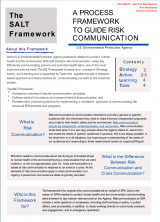Learn about Risk Communication
EPA’s mission is to protect human health and the environment. This important mission cannot be accomplished without communicating about risk with communities, individuals, businesses, the media, and state, local, and tribal partners. Risk communication is fundamental to the work we do. When we communicate risk, it is our goal to provide meaningful, understandable, and actionable information to our many audiences.
The Risk Paradigm
Through the processes of risk assessment, risk management, and risk communication, EPA works to understand risks posed to humans and the environment, manage those risks, and engage with audiences about them.
EPA's SALT Framework

EPA developed the SALT Framework as a tool to help ensure our risk communication activities follow best practice and are strategically aligned with the needs of the Agency and the American public.
EPA's SALT Framework is based on a process of Strategy, Action, and Learning and is supported by Tools that together provide a research-based approach and best practices for communicating our work to the American people.
Risk Communication across EPA
Staff at EPA fill many roles including scientists; policy makers; and legal, administrative, communication and engagement experts. Each of these roles can benefit from improved risk communication practice and tools, and leveraging the best available science from this field.
